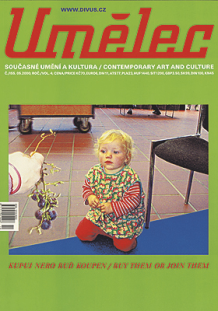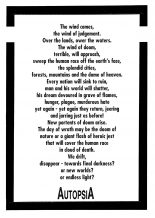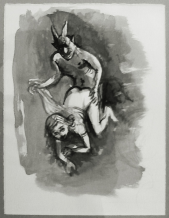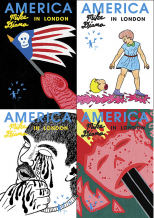| Umělec magazine 2004/4 >> Made in Belarus | List of all editions. | ||||||||||||
|
|||||||||||||
Made in BelarusUmělec magazine 2004/401.04.2004 Alena Boika | Belarus | en cs |
|||||||||||||
|
Konstantin Goretsky, a modern Belarusian artist, who works in different media such as painting, photography, and posters, created in 1987 a group of independent artists called KOMI-KON, that realized a number of significant projects among which was, Evacuation Plan. In 1996, he organized a musical and artistic salon, In an Attic, which hosted free art exhibitions and concerts for several years until its work was banned. At present, Goretsky works on art projects that combine various forms and means of expression. He lives and works in Minsk, Belarus.
- How did you think up the She-Goat and Scarecrow project? What happened in the beginning? It did not "happen." It grew from my whole life experience. A scarecrow indicates a problem in the relationship between the individual and power, and people and power. (People can be regarded as one huge individual). The project aims to visualize the complicated interrelations with power in all its manifestations. All my previous activities have been about the same subject. The clue is probably in my personality. I do not like any power: cultural, ideological, religious, the power of petty or high-ranking officers, the power of man over woman or woman over man. On the other hand, being a more or less sober-minded man, I see that the idea of power is necessary for social development. Anarchy, liberation, a kind of "the dawn of the earth" will unavoidably result in gangsterism. However, being a human being, I despise power. Anarchical nature, eccentricity, a sarcastic perception of the world—this is what is reflected in my works. I was born in the USSR in a professional soldier's family—a family of total power, where everything was clearly defined. For a long time, I was an absolutely happy child, who looked around the world with gleefulness, awe and hope. The Spasskaya Bashna, the Savior's Tower and the tanks on Red Square were my most favorite objects to draw as a child. Later, I developed a critical perception of the world and began to understand of the terrifying system of violence that we live in. The current political situation helped me to better understand the ideas I had developed earlier in life. The farcical repetition that we see in Belarus provokes perplexity and aversion because it displays utter lack of taste. It seemed that it could never be repeated. And now, it is all the same, but in an absurd and vulgar version. - In your project you use Belarusian folk characters: She-Goat, Scarecrow, and Stork. Since these are based upon Belarusian mythology can they then be exclusively national? No, I don’t consider this an exclusively Belarusian project. I am Belarusian; I use characters that are close to me. I am also a citizen of the world. What’s more, the problems of power, to which I seek to call attention, are absolutely universal. - Do you think that your solely visually presented ideas will be comprehensible to people from other countries, non-Belarusians? All societies have scarecrows. They look different but in essence they are the same. Fraser wrote about it in the Golden Bough. Mythologies of different peoples are very similar. The figures may vary but they are universally readable. Visual thinking has verbal expression. She-Goat, is a symbol of sexuality. She is stubborn and curious. She represents people who have tremendous sexual energy concentrated in them—something irrational, but which any power, like Scarecrow, would attempt to use. Scarecrow stands guard over the territory. If your goal is to guard, you need to scare; you invent various attractions, and that brings you to ideology. Scarecrow should be persuasive from the start. He should be handsome, he should promise something, delight, and be appealing. He then begins to scare saying, "enemies are everywhere" and to demonstratively punish as a lesson for others. Talented and convincing, Scarecrow is able to captivate and use She-Goat until she realizes that Scarecrow is nothing more than a bundle of brilliantly colored rags on wooden poles. "The Emperor has no clothes!" is a timeless mythological outcry. One need only be reminded that the 20th century’s strongest ideologies are the ones that put a spell on people. In the project, Stork personifies the educated class who despise people, who confidently calculate everything in belief that revolutions are nothing more than a set of mechanical combinations. I use this character to show that algebra of harmony is impossible. The free spirit flies wherever it wishes. - You work with archaic universal characters and defer to traditional technologies. Why do you think your project can be viewed as an aspect of contemporary art? I believe that there is no radically unknown form or technological innovation today. Everything exists in our head and in the universe; it just depends on how you look at it. That’s contemporary art. However, most of our artists don’t so much play on interpretations of style—they interpret phenomena. As far as technology is concerned, I’d rather not reveal everything until the project is done. - You said the project is cosmopolitan. Do you intend to involve foreign participants? Are you planning to exhibit it outside of Belarus? Of course, I would be glad to see participants from everywhere. It could become a very fruitful collaboration. The more people who participate, the more forms of response. Visual forms are possible. The terrorism that threatens the world represents an evolutionary defect of civilization, in which one part cannot meet requirements and expectations of another. - You interpret She-Goat and Scarecrow as a project designed to make people laugh. Do you believe that these figures are readable and understandable? I am sure the project has the potential to be understood. This is why participation of other artists is important to me. I want to make it more picturesque with a performance that is as expressive as at a fair—and a video, the modern substitute for cinema. My patent way of painting is in this style. I believe that it is understandable and expressive enough. You cannot turn art into the flow of funny things. The grotesque must remain artistic. If we manage to create a synthetic phenomenon, it will be understandable. - The project characters and main idea is to make She-Goat see that power is only a Scarecrow and to make her laugh. Would you then say that the project’s broader goal is to revolutionize society? It is just a pebble, a mosquito's sting, which, of course, is not enough. You should understand that power is violence and violence is sexual. This is why you cannot defeat it with rational weapons. You can only stop it through laughter. I create striking images that inspire laughter in some and others to at least grin. Any power fears laughter. Punch and Judy, those fools and jesters, loved by the common people, troubled the high and mighty. Another example is the Belarusian newspaper Navinki; it parodied issues of the day and it was closed down. I could speak at length about cultural repression and its distinction from art, which is free. - Do you think you have the technical wherewithal to realize your idea in Belarus, to complete what you began and to present it to the general public? There is almost no hope that I can show the project in full measure in Belarus. This is an extremely local and closed country, which by no means makes for free art. Our Scarecrow mastered the lessons of the USSR’s collapse. Confronted with some outstanding form it fails to grasp, the high and mighty rush off ban it "just in case." Needless to say, even the slightest support from state institutions of culture is impossible. If only they would not interfere! I’d be content if I could just issue a comic book to everybody in this country. - In conclusion, how would you describe the current state of Belarusian art? It is disgusting, provincial, dreary and worthless. Provincial narcissism, conscious superiority grown from provinciality is typical. In Belarusian art technique held in high esteem; that’s important, but as a virtue it is insufficient. Those whose work fails to fit in with this standard will be expelled. Everyone is anxious about production--to produce more milk and potatoes or to better cover canvas with paint. Most art in Belarus is a dreary and small imitation of third-rate western art. There is no Belarusian art. It is a workshop that sometimes produces high-quality things. This art cannot be recognized abroad as anything considerable because it isn’t allowed to grow freely in the fields. Here it is all calculated and precise. Belarusian art is dictated by the culture—that is the fundamental problem. P.S. Contact information for people interested in collaboration and participation in the project: http://kartinki.iatp.by (http://kartinki.oxidiser.net) , kgoretsky@yahoo.com, elena@iatp.by
01.04.2004
Recommended articles
|
|||||||||||||
|
04.02.2020 10:17
Letošní 50. ročník Art Basel přilákal celkem 93 000 návštěvníků a sběratelů z 80 zemí světa. 290 prémiových galerií představilo umělecká díla od počátku 20. století až po současnost. Hlavní sektor přehlídky, tradičně v prvním patře výstavního prostoru, představil 232 předních galerií z celého světa nabízející umění nejvyšší kvality. Veletrh ukázal vzestupný trend prodeje prostřednictvím galerií jak soukromým sbírkám, tak i institucím. Kromě hlavního veletrhu stály za návštěvu i ty přidružené: Volta, Liste a Photo Basel, k tomu doprovodné programy a výstavy v místních institucích, které kvalitou daleko přesahují hranice města tj. Kunsthalle Basel, Kunstmuseum, Tinguely muzeum nebo Fondation Beyeler.
|







































 New book by I.M.Jirous in English at our online bookshop.
New book by I.M.Jirous in English at our online bookshop.
Comments
There are currently no comments.Add new comment